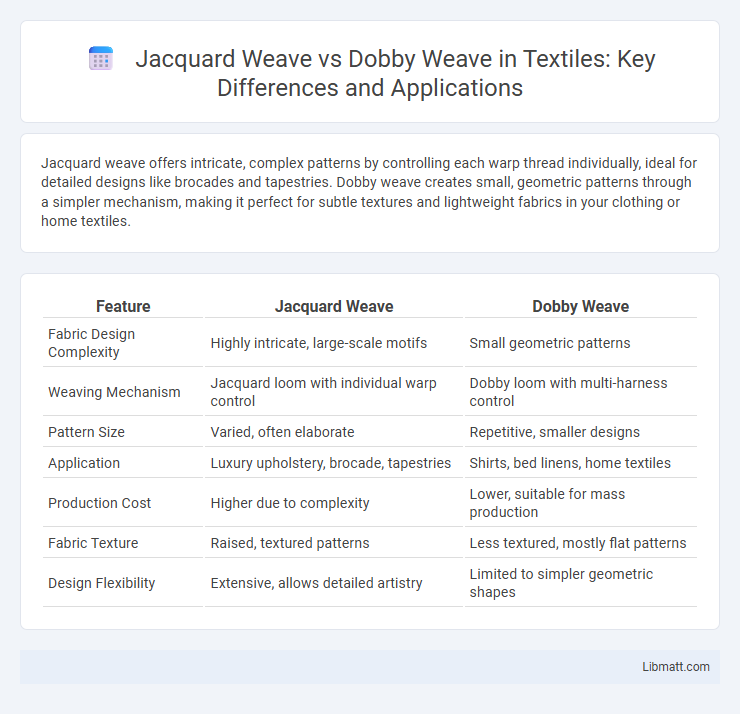Jacquard weave offers intricate, complex patterns by controlling each warp thread individually, ideal for detailed designs like brocades and tapestries. Dobby weave creates small, geometric patterns through a simpler mechanism, making it perfect for subtle textures and lightweight fabrics in your clothing or home textiles.
Table of Comparison
| Feature | Jacquard Weave | Dobby Weave |
|---|---|---|
| Fabric Design Complexity | Highly intricate, large-scale motifs | Small geometric patterns |
| Weaving Mechanism | Jacquard loom with individual warp control | Dobby loom with multi-harness control |
| Pattern Size | Varied, often elaborate | Repetitive, smaller designs |
| Application | Luxury upholstery, brocade, tapestries | Shirts, bed linens, home textiles |
| Production Cost | Higher due to complexity | Lower, suitable for mass production |
| Fabric Texture | Raised, textured patterns | Less textured, mostly flat patterns |
| Design Flexibility | Extensive, allows detailed artistry | Limited to simpler geometric shapes |
Introduction to Jacquard and Dobby Weaves
Jacquard weave is a complex textile pattern created by a loom with a jacquard mechanism, enabling intricate designs such as florals and detailed motifs through individually controlled warp threads. Dobby weave features geometric or simple repetitive patterns designed on a dobby loom, producing textured fabrics with smaller, regular motifs like dots or diamonds. Understanding the fundamental distinction between Jacquard's elaborate patterns and Dobby's structured, minimalist designs allows you to select the most suitable weave for your fabric needs.
Historical Overview of Jacquard and Dobby Weaving
Jacquard weaving originated in the early 19th century with Joseph Marie Jacquard's invention of the Jacquard loom, which enabled intricate, programmable patterns through punched cards, revolutionizing textile production. Dobby weaving, developed later in the 20th century, uses a simpler mechanism suitable for small geometric patterns and textures, making it more accessible for mass production. Both weaving techniques significantly impacted fabric design by introducing automated control, with Jacquard focusing on complex motifs and Dobby on repetitive, textured designs.
Key Differences in Weaving Mechanisms
Jacquard weave employs a complex mechanism with individual control of each warp thread, allowing for intricate, detailed patterns and large-scale designs. In contrast, Dobby weave uses a simpler dobby loom mechanism that controls small groups of warp threads, producing geometric and repetitive patterns with less complexity. The Jacquard loom's punch card system enables greater versatility in pattern creation compared to the limited, mechanical lifting of warp threads in Dobby weaving.
Design Complexity: Jacquard vs Dobby
Jacquard weave supports highly intricate and detailed patterns by controlling each warp thread individually, enabling complex designs such as florals and paisleys. Dobby weave offers moderate design complexity with geometric patterns and small repeating motifs created through limited warp harnesses. The extensive thread manipulation in Jacquard allows for more elaborate textures compared to the simpler, grid-like patterns typical in Dobby weaving.
Fabric Applications and Uses
Jacquard weave fabrics are extensively used in upholstery, drapery, and fashion due to their intricate, large-scale designs that provide decorative and luxurious aesthetics. Dobby weave fabrics often find applications in shirting, bed linens, and lightweight apparel, valued for their subtle geometric patterns and textured surfaces that enhance breathability and comfort. Both weaves offer versatility, with Jacquard excelling in ornamental textiles and Dobby favored for casual, everyday fabric needs.
Visual Appearance and Pattern Capabilities
Jacquard weave produces intricate, large-scale patterns with high detail and vibrant textures due to its complex lifting mechanism, allowing each warp thread to be controlled independently. Dobby weave creates small, geometric, repetitive patterns with a more subtle texture, relying on a simplified harness system that lifts multiple threads simultaneously. The Jacquard method offers greater versatility for elaborate designs, while Dobby is ideal for simpler motifs and structured textures.
Production Speed and Efficiency
Jacquard weave production is generally slower due to the complexity of its intricate patterns and the use of advanced punched card or computer-controlled mechanisms. Dobby weave offers higher production speed and efficiency as it handles simpler geometric patterns with less intricate control, making it suitable for mass production. Your choice depends on whether you prioritize detailed design complexity or faster fabric output.
Cost Implications of Jacquard and Dobby Fabrics
Jacquard fabrics typically incur higher production costs due to their intricate, large-scale patterns and the complexity of their weaving process, requiring specialized looms and more time. Dobby fabrics, characterized by smaller, geometric patterns, are generally more cost-effective to produce, involving simpler loom setups and less labor-intensive techniques. Understanding these cost implications can help you make informed decisions when selecting fabrics for budget-conscious projects or luxury designs.
Durability and Care Considerations
Jacquard weave features complex patterns woven directly into the fabric, resulting in a thicker and more durable textile compared to the simpler, geometric designs of dobby weave. Jacquard fabrics often require gentler care, such as hand washing or dry cleaning, to maintain their intricate designs and longevity, while dobby weave can typically withstand more frequent machine washing and regular maintenance. Your choice between the two weaves should consider the balance of durability and the level of care you are willing to provide for the fabric's upkeep.
Choosing Between Jacquard and Dobby Weaves
Choosing between Jacquard and Dobby weaves depends on the complexity of the design and fabric texture desired. Jacquard weaves produce intricate, large-scale patterns ideal for detailed floral or damask motifs, while Dobby weaves create smaller, geometric, and textured patterns suitable for subtle elegance. Fabric durability and intended use also influence selection, with Jacquard suited for upholstery and formal wear, and Dobby often favored for lightweight shirts and home textiles.
Jacquard weave vs Dobby weave Infographic

 libmatt.com
libmatt.com